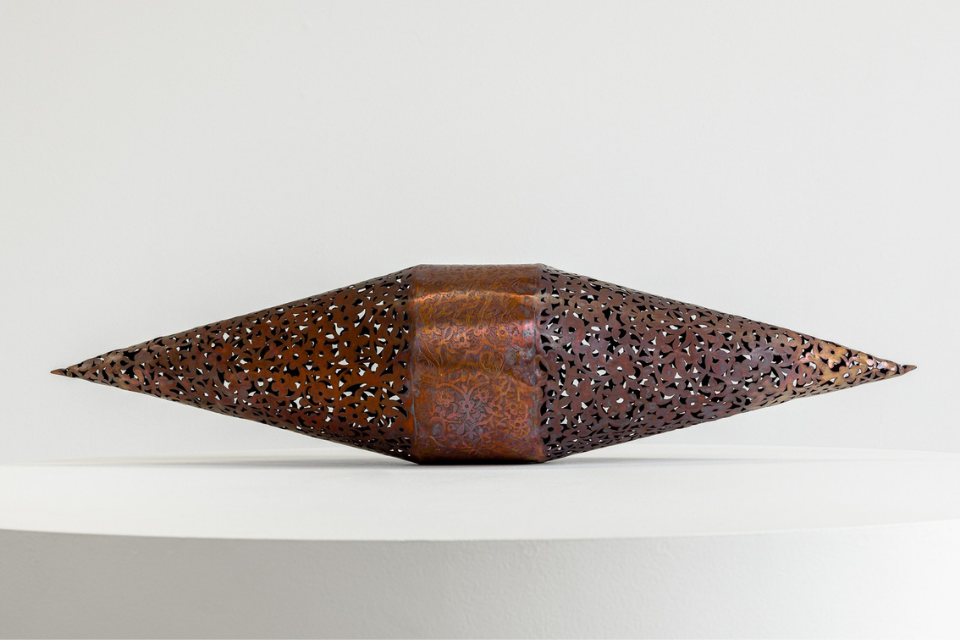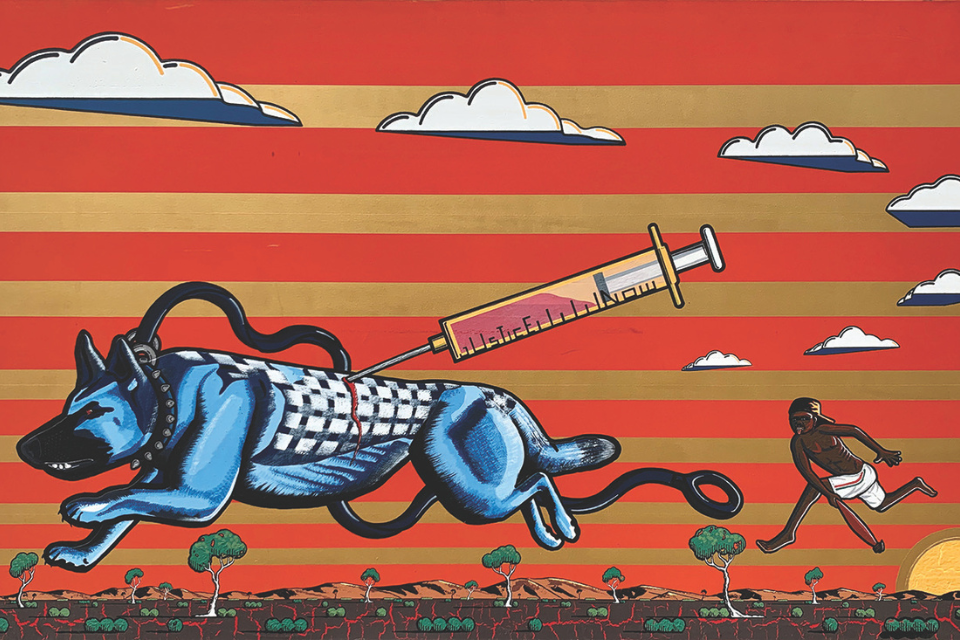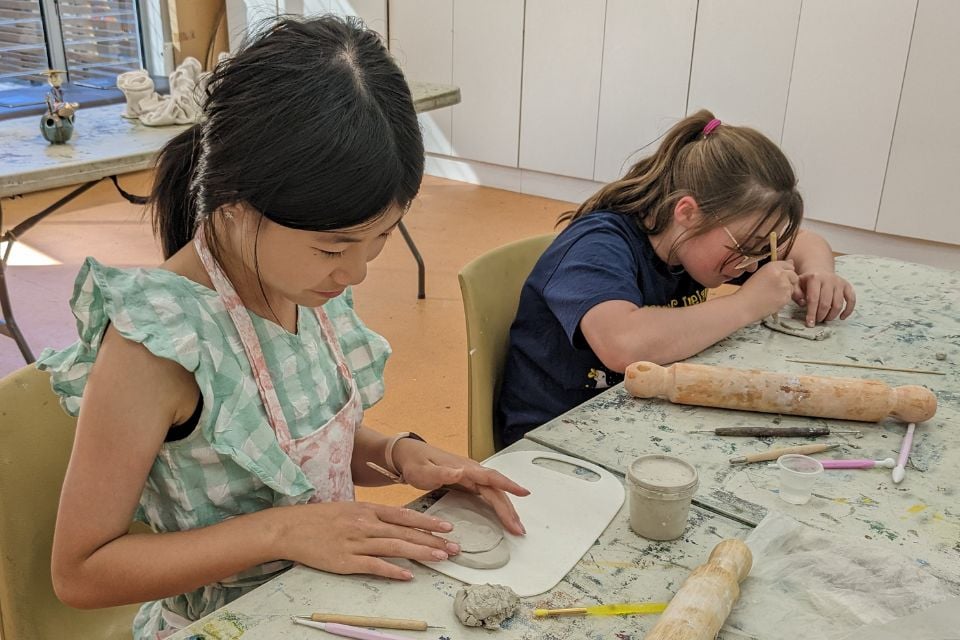Hibiscus: Angela Tiatia & Philip Juster
2 August - 26 October 2025
Hibiscus creates a dialogue between works by Angela Tiatia (b. 1973) and Philip Juster (1952–2004), highlighting their shared interests in questions around colonialism and the representation of Pacific places and peoples in European art. Based on Gadigal Land in Sydney, Tiatia is one of Australia’s foremost practitioners in lens-based media, drawing on her Samoan heritage in her exploration of aspects of contemporary culture, including representation, gender and colonialism and the commodification of body, history and place. The Penrith Regional Gallery is home to the most substantial publicly-owned collection of works by Juster, a significant contributor to the visual culture that emerged from the intersections of art, activism and identity in Sydney in the late 1970s. Brisbane-born Juster’s extensive body of work in collage and painting as well as sculpture, textiles and wearable art combines an enduring interest in Chinese, Indian, South-East Asian and Pacific cultures with an incisive, often irreverent post-colonial sensibility. This exhibition will highlight the connections between two artists disconnected by time, medium and background, situating a selection of Juster’s collage series in conversation with Tiatia’s The Pearl, a major digital installation commissioned by the Art Gallery of New South Wales in 2021. With a focus on the performativity and playfulness characteristic of each artist’s work, this timely exhibition highlights the many layers of meaning resulting from a multi-medium, cross-cultural approach.
In Tiatia’s The Pearl, a lolly pink plastic clamshell paddling pool is the catalyst for a lush digital reimagining of the mythological story of the birth of Venus, and of Henri Matisse’s sculpture Venus á la coquille. At the same time, The Pearl explores the connection between the Tivaevae (quilting) and tapa cloth making traditions of the Pacific, witnessed by Matisse during a visit to Tahiti, and the paper cut-out technique which subsequently became his primary medium and the method by which he executed major late works evocative of shells, seas, corals, and tropical flora. Combined with a pearlescent shell and a hibiscus flower – symbolic in European art of the ‘exotic’ South Seas – the clamshell pool of Tiatia’s work mimics both the form and making of Matisse’s late works before drawing the viewer into an immersive, expansive journey ‘across and within a digital tapa cloth.’ Computer-generated images of waterfalls, waves, palms and pearls are collaged into an exuberant, potent reclamation of Polynesian imagery, objects and creative practices, disrupting the stereotypes established by Western art and enacting a powerful vision of contemporary Pacific women and culture. ‘I wanted to present a world of the hyper-real, hyper-beautiful, hyper-surreal’, Tiatia says, and ‘comment on visual techniques and styles that are growing in potency.’
Philip Juster’s collage works create unexpected yet revealing parallels. With lived experience as part of a community traditionally subjected to othering and marginalisation, Juster used collage – formerly derided by art history as the medium of amateurs – to create series of works parodying the commodification and objectification of non-western cultures and places, and drawing attention to issues of colonialism, collecting, religious imperialism and dispossession. From 1978, when he took part in the exhibitions marking the inaugural Sydney Gay & Lesbian Mardi Gras, up until shortly before his death in 2004, Juster exhibited in group and solo shows in Sydney, Brisbane, Los Angeles and New York, his works blending the kitsch sensibility of postcards and tourist paraphernalia with the language of pop, punk, psychedelia and leftist propaganda. A series of untitled collages from 1997, for example, shows traditional Pacific sculptures making symbolic escapes from museums and cabinets of curiosity; while in others, the First Peoples depicted in colonial-era Australian paintings launch spears at Abel Tasman and Captain Cook. Other series, subverting the trope of the ‘Noble Savage’, contrast neo-classical European prints of tattooed Polynesian warriors with portraits of European explorers, monarchs and Bible-wielding nuns; and others take the form of posters for imagined B-grade movies with titles such as ‘The Last Crusade: Hinduism v. Christianity’. A visit to the Pacific atolls of Kiribati instigated a thematic shift in Juster’s work, seeing the incorporation of exoticised motifs such as hibiscus flowers, leis and palm trees, and works in which these symbols are collaged with lager labels, crucifixes, and images of Queen Elizabeth II. Juster’s friend Robert Lake says: ‘For me, two key moments were [Juster’s] trip to the Pacific and a day spent among the glass display cabinets in the subterranean storage area housing the Pacific collection of the Museum für Völkerkunde in 1983. These two journeys had a profound effect on Juster’s oeuvre and continuing relevance.’ A posthumous exhibition of Juster’s collages held at Tin Sheds Gallery in 2011, art critic John McDonald wrote, showed ‘a verve and intelligence that testifies to a promising career cut short.’
A collaborative curatorial project between Angela Tiatia and PRG, Hibiscus represents an exciting opportunity for the consolidation and expansion of the Gallery’s connections with diverse audiences across greater western Sydney, and will be accompanied by public programs and performances created specifically for the exhibition by companies including Matavai Pacific Cultural Arts. The exhibition is part of the suite of exhibitions and engagement programs being developed by Penrith Regional Gallery in collaboration with the curatorial, collections and touring exhibitions teams at the Art Gallery of New South Wales and generously supported by TLE Electricals. Hibiscus will be presented at PRG from August to November 2025.
- Key Info:
- Dates & Times
02 Aug 2025 12:00 am
26 Oct 2025 12:00 am



